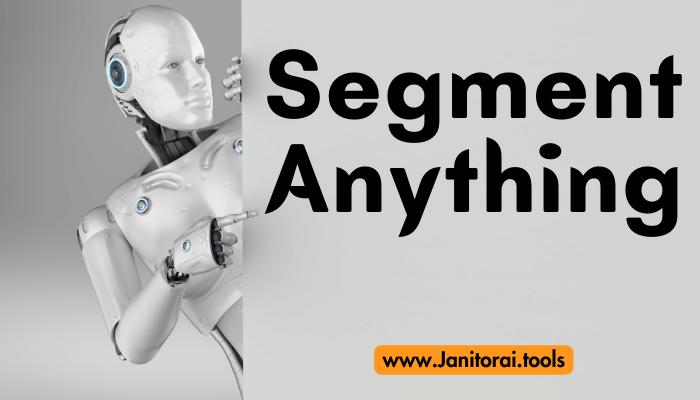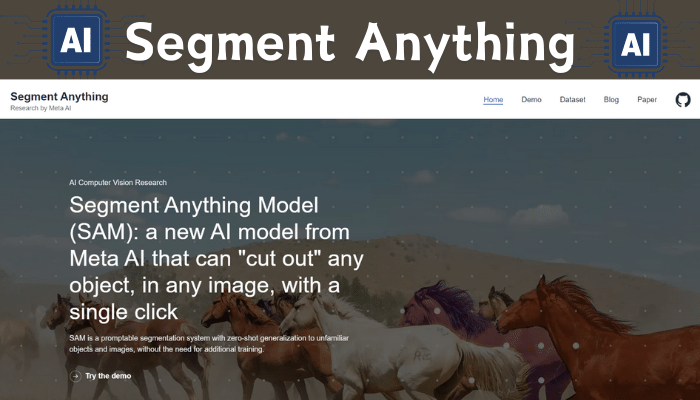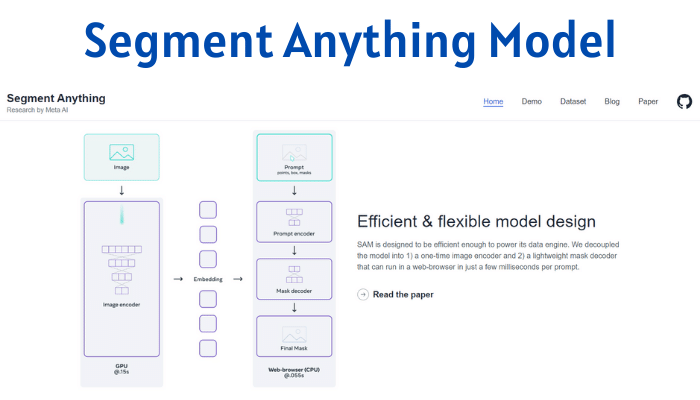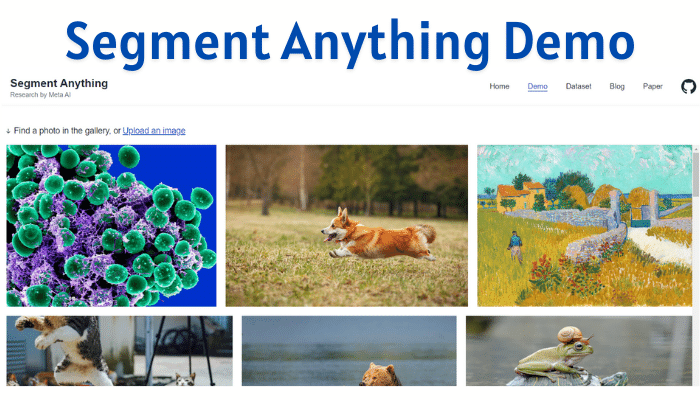Are you tired of tedious object identification in images? Are you longing for an AI tool that can pinpoint anything you desire? Buckle up, because Segment Anything (SAM) is here to revolutionize your computer vision experience. This comprehensive guide dives deep into the world of SAM, unveiling its capabilities, applications, and how you can leverage its magic for your projects.
Forget clunky, single-purpose solutions. SAM empowers you to segment anything, from everyday objects to intricate medical scans. We’ll explore the brains behind SAM, its impressive training data, and how it achieves unmatched segmentation accuracy. So, whether you’re a developer, researcher, or a curious tech enthusiast, this guide is your one-stop shop for mastering Segment Anything AI.

What is Segment Anything?
It is an AI model designed to segment objects in images with high precision and efficiency. It is a versatile tool that can identify and separate multiple objects within a single image, regardless of the complexity or number of objects present.
The model is based on a new approach called “Segment Anything Query” (SAQ). SAQ lets users specify objects to it. They can do this with a simple text prompt or by clicking on the image. This interactive approach makes segmentation easy to use, even for beginners. With SAQ, even non-experts can leverage the power of AI for image segmentation tasks.
Methodology
The methodology behind it is based on a combination of transformer-based architectures and advanced computer vision techniques. This model leverages a pre-trained encoder-decoder architecture, which it then fine-tunes on a large dataset of diverse images with segmentation annotations.
During the training process, the model learns to understand the visual characteristics and relationships between objects in images. It develops a deep understanding of object shapes, textures, and contexts, enabling it to accurately identify and separate objects from their surroundings.

How Segment Anything Model Works
The SAM operates in two main stages: encoding and decoding.
The Segment Anything Model (SAM) Architecture
- Encoding Stage: In this stage, the input image is processed by a convolutional neural network (CNN) to extract low-level visual features, such as edges, textures, and colors.
- Decoding Stage: The extracted features are then fed into a transformer-based decoder, which generates a segmentation mask for the specified object(s). The decoder utilizes self-attention mechanisms to capture long-range dependencies and relationships between different parts of the image, allowing for accurate segmentation of complex objects.
Key Features of the Segment Anything Model (SAM)
- Interactive Segmentation: SAM allows users to specify the object(s) they want through simple text prompts or mouse clicks, making the process intuitive and user-friendly.
- Multi-Object Segmentation: The model can segment multiple objects within a single image, making it suitable for a wide range of applications.
- High Accuracy: SAM achieves state-of-the-art performance in image segmentation tasks, outperforming many traditional and deep learning-based methods.
- Efficient Inference: The model is designed for efficient inference, allowing for real-time segmentation on a variety of hardware platforms, including mobile devices.
Segment Anything Model Vs. Previous Foundation Models
While previous foundation models, such as DALL-E and Stable Diffusion, have achieved remarkable success in image generation and manipulation, It represents a significant advancement in the field of image segmentation.
Segment Anything specifically targets segmenting individual objects within images with high precision, unlike other models that focus primarily on generating or manipulating entire images. This specialized capability makes it a valuable tool for a wide range of applications that require accurate object segmentation, such as computer vision, augmented reality, and medical imaging.

Applications of Segment Anything Model
The it model has numerous potential applications across various industries and domains, including:
- Computer Vision: Object detection, recognition, and tracking in real-world scenarios.
- Augmented Reality (AR): Seamless integration of virtual objects into real-world environments by accurately segmenting and separating background elements.
- Medical Imaging: Precise segmentation of anatomical structures, tumors, and lesions, aiding in diagnosis and treatment planning.
- Robotics and Automation: Accurate perception and segmentation of objects for robotic grasping and manipulation tasks.
- Agriculture: Identification and segmentation of crops, weeds, and pests for precision farming and yield optimization.
Segment Anything Pricing
Meta AI has not yet announced the pricing model for it. However, given the model’s potential impact and widespread applications, it is expected to be available through various licensing and subscription options to cater to different users and industries.
Segment Anything Pros and Cons

Pros:
- High accuracy in object segmentation tasks
- User-friendly interactive segmentation
- Multi-object segmentation capability
- Efficient inference for real-time applications
- Versatile and applicable across various domains
Cons:
- Limited availability and pricing information
- Potential ethical and privacy concerns with Object Segmentation Technology
- Dependency on the quality and diversity of training data
Segment Anything Login and Sign Up
As of now, Segment Anything is not yet publicly available for login or sign-up. However, once it is released, the process is expected to be similar to other AI services:
- Visit the official website (segment-anything.com).
- Look for the “Sign Up” or “Create Account” button on the homepage.
- Fill out the registration form with your email address and create a secure password.
- Verify your email address by clicking the confirmation link sent to your inbox.
- Complete any additional steps required, such as selecting a payment plan or providing necessary information.
- Once your account is set up, you can log in using your email and password to access the Segment Anything platform.
Alternatives for Segment Anything
- Remove. bg (Effortless Background Removal): This user-friendly platform removes image backgrounds in seconds, ideal for quick and clean edits.
- DeepAI (DIY Object Segmentation): For developers and tech-savvy users, DeepAI offers customizable object segmentation tools, allowing you to train your models.
- SuperAnnotate (All-in-one AI Annotation): SuperAnnotate goes beyond segmentation, providing a comprehensive platform for labeling and annotating images and videos for various machine learning projects.
- VGG Image Annotator (Open-source Segmentation Powerhouse): Looking for a free and powerful option? VGG Image Annotator is an open-source tool used by researchers and hobbyists to segment objects with ease.
- Adobe Photoshop (AI-Assisted Segmentation): The industry standard for image editing, Photoshop now offers AI-powered selection tools that can help you segment objects with greater accuracy.
- ResearchRabbit: ResearchRabbit helps researchers explore & connect scholarly articles like a visual Spotify for science papers.

FAQs
Segment Anything (SAM) is an AI tool that acts like a digital paintbrush, letting you precisely identify and isolate objects within any image.
In a general sense, a segment can mean a distinct section of something, like a part of a circle or a business division.
It offers the code and model for free, but the license restricts commercial use of the data it generates. Consider open-source alternatives for commercial projects.
Segment Anything offers an interactive and user-friendly approach to image segmentation, allowing users to specify objects through simple text prompts or mouse clicks. It also demonstrates high accuracy and efficient inference for real-time applications.
Yes, Segment Anything can segment multiple objects within a single image, making it suitable for various applications that require multi-object segmentation.
It has numerous potential applications, including computer vision, augmented reality, medical imaging, robotics and automation, and precision agriculture.
While DALL-E and Stable Diffusion excel at generating and manipulating entire images, Segment Anything is specifically designed for precise object segmentation within images, making it a specialized tool for this task.
Conclusion
The Segment Anything (SAM) model ushers in a new era of image segmentation. This comprehensive guide explored SAM’s capabilities, from its innovative promptable design to the creation of the massive SA-1B dataset. SAM empowers users to segment a vast array of objects with minimal human intervention.
Its applications range from streamlining content creation to medical advancements. As research on SAM continues, its potential to revolutionize image processing is undeniable. This guide has equipped you to harness the power of SAM and explore its possibilities for your own projects.
